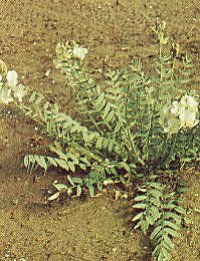TIMBER
MILKVETCH


Description
Flowers of the timber milkvetch resemble sweetpeas. They vary in color from creamy-white to shades of violet.

Timber milkvetch is a poisonous plant that affects cattle and -occasionally-sheep. Cattle of all ages are highly susceptible to the poisoning. Even when other forage is available, cattle readily eat it.
Sheep graze it sparinly unless they have no other forage. Plants are poisonous from emergence until they dry up in late summer or are killed by frost. Milkvetch poisoning may be mistaken for larkspur poisoning. The poisonous substance has not been identified.

Where and When It Grows
The plant grows at elevations of 6,000 to 11,000 feet in the Rocky Mountain States. Isolated stands also occur in the Black Hills of South Dakota. The plant is found on open, well-drained meadows. It emerges soon after snow melts in late May or early June. It flowers in June and July and produces seeds in slender pods in August. Leaves and stems become dry and are less dangerous after the seed matures.

How It Affects Livestock
Timber milvetch acts quickly. Two pounds of the green plant may cause acute poisoning or death in a 1,000-pound cow. Some deaths occur within 1 hour- so fast that cattle show no signs; more often, animals die within 3 or 4 hours of eating the plant.
milkvetch poisoning is characterized by a general muscular weakness. It paralyzes leg muscles so that affected animals fall after the slightest excitement, although they appear bright. The heart beats very fast before the animal dies from heart failure.
Signs of timber milkvetch poisoning resemble those of larkspur poisoning, with which they are often confused.

Signs of poisoning
1. Nervousness
2. Frequent urination
3. Irregular gait
4. Muscular weakness, causing inability to stand
5. Rapid, weak pulse
6. White coloration of the lining of the mouth
7. Coma
8. Convulsions

BACK TO INDEX
H O M E
Would You Consider Signing
My Book?










